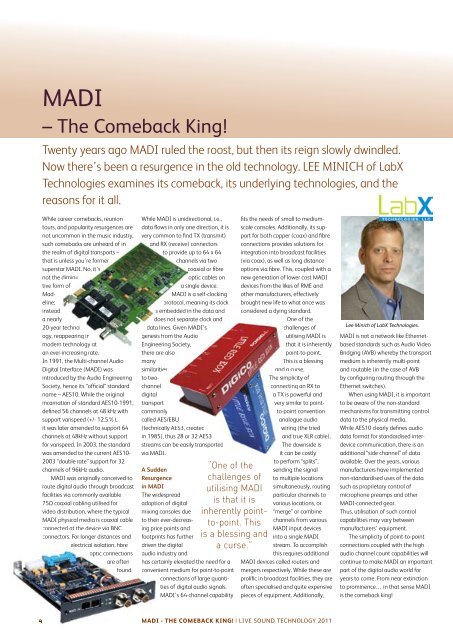1480 461555 E-mail: a.brown@audiomedia.com
1480 461555 E-mail: a.brown@audiomedia.com
1480 461555 E-mail: a.brown@audiomedia.com
Create successful ePaper yourself
Turn your PDF publications into a flip-book with our unique Google optimized e-Paper software.
MADI<br />
– The Comeback King!<br />
Twenty years ago MADI ruled the roost, but then its reign slowly dwindled.<br />
Now there’s been a resurgence in the old technology. LEE MINICH of LabX<br />
Technologies examines its <strong>com</strong>eback, its underlying technologies, and the<br />
reasons for it all.<br />
While career <strong>com</strong>ebacks, reunion<br />
tours, and popularity resurgences are<br />
not un<strong>com</strong>mon in the music industry,<br />
such <strong>com</strong>ebacks are unheard of in<br />
the realm of digital transports –<br />
that is unless you’re former<br />
superstar MADI. No, it’s<br />
not the diminutive<br />
form of<br />
Madeline;<br />
instead<br />
a nearly<br />
20-year technology,<br />
reappearing in<br />
modern technology at<br />
an ever-increasing rate.<br />
In 1991, the Multi-channel Audio<br />
Digital Interface (MADI) was<br />
introduced by the Audio Engineering<br />
Society, hence its “official” standard<br />
name – AES10. While the original<br />
incarnation of standard AES10-1991,<br />
defined 56 channels at 48 kHz with<br />
support varispeed (+/- 12.5%),<br />
it was later amended to support 64<br />
channels at 48kHz without support<br />
for varispeed. In 2003, the standard<br />
was amended to the current AES10-<br />
2003 “double rate” support for 32<br />
channels of 96kHz audio.<br />
MADI was originally conceived to<br />
route digital audio through broadcast<br />
facilities via <strong>com</strong>monly available<br />
75Ω coaxial cabling utilised for<br />
video distribution, where the typical<br />
MADI physical media is coaxial cable<br />
connected at the device via BNC<br />
connectors. For longer distances and<br />
electrical isolation, fibre<br />
optic connections<br />
are often<br />
found.<br />
While MADI is unidirectional, i.e.,<br />
data flows in only one direction, it is<br />
very <strong>com</strong>mon to find TX (transmit)<br />
and RX (receive) connectors<br />
to provide up to 64 x 64<br />
channels via two<br />
coaxial or fibre<br />
optic cables on<br />
a single device.<br />
MADI is a self-clocking<br />
protocol, meaning its clock<br />
is embedded in the data and<br />
does not separate clock and<br />
data lines. Given MADI’s<br />
genesis from the Audio<br />
Engineering Society,<br />
there are also<br />
many<br />
similarities<br />
to two-<br />
channel<br />
digital<br />
transport<br />
<strong>com</strong>monly<br />
called AES/EBU<br />
(technically AES3, created<br />
in 1985), thus 28 or 32 AES3<br />
streams can be easily transported<br />
via MADI.<br />
“One of the<br />
challenges of<br />
utilising MADI<br />
is that it is<br />
inherently pointto-point.<br />
This<br />
is a blessing and<br />
a curse.”<br />
A Sudden<br />
Resurgence<br />
in MADI<br />
The widespread<br />
adoption of digital<br />
mixing consoles due<br />
to their ever-decreas-<br />
ing price points and<br />
footprints has further<br />
driven the digital<br />
audio industry and<br />
has certainly elevated the need for a<br />
convenient medium for point-to-point<br />
connections of large quantities<br />
of digital audio signals.<br />
MADI’s 64-channel capability<br />
fits the needs of small to mediumscale<br />
consoles. Additionally, its support<br />
for both copper (coax) and fibre<br />
connections provides solutions for<br />
integration into broadcast facilities<br />
(via coax), as well as long distance<br />
options via fibre. This, coupled with a<br />
new generation of lower cost MADI<br />
devices from the likes of RME and<br />
other manufacturers, effectively<br />
brought new life to what once was<br />
considered a dying standard.<br />
One of the<br />
challenges of<br />
utilising MADI is<br />
that it is inherently<br />
point-to-point.<br />
This is a blessing<br />
and a curse.<br />
The simplicity of<br />
connecting an RX to<br />
a TX is powerful and<br />
very similar to pointto-point<br />
convention<br />
analogue audio<br />
wiring (the tried<br />
and true XLR cable).<br />
The downside is<br />
it can be costly<br />
to perform “splits”,<br />
sending the signal<br />
to multiple locations<br />
simultaneously, routing<br />
particular channels to<br />
various locations, or<br />
“merge” or <strong>com</strong>bine<br />
channels from various<br />
MADI input devices<br />
into a single MADI<br />
stream. To ac<strong>com</strong>plish<br />
this requires additional<br />
MADI devices called routers and<br />
mergers respectively. While these are<br />
prolific in broadcast facilities, they are<br />
often specialised and quite expensive<br />
pieces of equipment. Additionally,<br />
Lee Minich of LabX Technologies.<br />
MADI is not a network like Ethernetbased<br />
standards such as Audio Video<br />
Bridging (AVB) whereby the transport<br />
medium is inherently multi-point<br />
and routable (in the case of AVB<br />
by configuring routing through the<br />
Ethernet switches).<br />
When using MADI, it is important<br />
to be aware of the non-standard<br />
mechanisms for transmitting control<br />
data to the physical media.<br />
While AES10 clearly defines audio<br />
data format for standardised interdevice<br />
<strong>com</strong>munication, there is an<br />
additional “side channel” of data<br />
available. Over the years, various<br />
manufacturers have implemented<br />
non-standardised uses of the data<br />
such as proprietary control of<br />
microphone preamps and other<br />
MADI-connected gear.<br />
Thus, utilisation of such control<br />
capabilities may vary between<br />
manufacturers’ equipment.<br />
The simplicity of point-to-point<br />
connections coupled with the high<br />
audio channel count capabilities will<br />
continue to make MADI an important<br />
part of the digital audio world for<br />
years to <strong>com</strong>e. From near extinction<br />
to prominence… in that sense MADI<br />
is the <strong>com</strong>eback king!<br />
4 MADI - THE COMEBACK KING!<br />
| LIVE SOUND TECHNOLOGY 2011
















